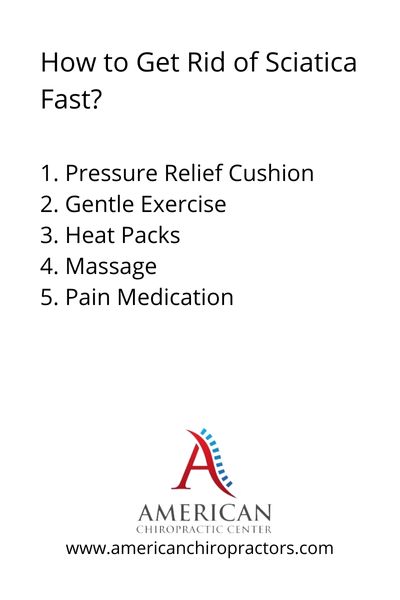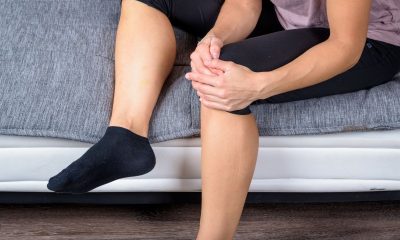Sciatica
How to Cure Sciatica Permanently?

Sciatica is a common type of back pain that can be caused by many things, such as spinal stenosis, herniated discs, or muscle spasms. It is a debilitating condition that affects the sciatic nerve.
The cause of sciatica can be due to many factors, including aging, injury, or degeneration of the spine. Many people experience significant pain in their back and buttocks when they have Sciatica. Sciatica may also lead to numbness in your foot or leg, which can limit your mobility and range of motion.
Read more about How Do I Cure Sciatica Permanently

It usually occurs on one side of the body and can radiate down to the leg, creating numbness and tingling sensations. Sciatica has been linked with other conditions like arthritis and diabetic neuropathy, so it’s best to see a doctor for an accurate diagnosis if you’re experiencing sciatic-like symptoms.
More about How Do I Cure Sciatica Permanently

It has been estimated by the National Institute of Neurological Disorders and Stroke that more than 50% of people will experience Sciatica sometime in their lives. The pain can range from mild discomfort to excruciatingly debilitating chronic pain.
If you are experiencing these problems, it’s important to see a physician right away so you can get treatment for your symptoms as soon as possible. Fortunately, there are many ways you can get relief for your sciatica symptoms without going to a physician. Learn how you too can get on top of your Sciatica and start living again.
In this post, we’ll explore how to cure sciatica permanently through exercises, stretches, and lifestyle changes.
Sciatica Treatment Overview
An individual with Sciatica can experience pain that radiates down the back of the thigh and into the lower leg. One or more of the lower spinal nerves may be irritated. It may be mild or severe pain and often develops as a result of wear and tear on the lower spine. In most cases, Sciatica can be treated with conservative treatment methods within a few weeks without requiring surgery. Increasing your flexibility throughout your hips and lower body while strengthening your back and core will reduce your chances of suffering from low back pain and other symptoms of Sciatica.
Symptoms and Signs
There can be a wide range of symptoms associated with Sciatica, which extend from the lower back down the hips and down the leg to cause excruciating pain. Some sufferers also report hip pain, upper back pain, neck pain, knee pain and shoulder pain as a symptom that arises as the pain travels the lumbar spine into the hip and shoulder. There may be numbness, tingling sensations, or muscle weakness that travels down the back of your thigh into your calf or foot. Coughing or sneezing can make it worse. Most people suffering from Sciatica will experience symptoms on only one side of their bodies. It is often possible to relieve sciatica pain through physical therapy, chiropractic, and massage treatments, strengthening and flexibility exercises, and the application of hot and cold packs.
Will the pain go away on its own?
Sciatic nerve pain demands active management since sciatica does not go away on its own. Sciatica is typically a sign of an underlying cause such as tight and weaker hip flexors and piriformis muscles. It might also be caused by a bulging or ruptured disc, spinal trauma, or pelvic misalignment.
If left untreated, this illness may progress and cause terrible pain. If you do not treat the underlying source of the problem, the intensity of your sciatic pain may worsen with time. Pain can reduce your quality of life by interfering with your ability to sleep, sit, or even move.
Potential Sciatica Risk Factors
Sciatica can be caused by a number of factors, which can affect both athletes and less active people. Sedentary lifestyles are more likely to cause Sciatica than active lifestyles. Endurance athletes, however, are also prone to Sciatica due to overworked and stiff muscles.
Age also plays a significant role, with those between 30 and 60 often suffering from age-related degeneration in their spine, such as spinal column disc herniation, degenerative disc disease, bone spurs, and hip joint dysfunction. The Mayo Clinic reports that obesity and diabetes are also common contributors.
The type of sciatica pain you encounter is determined by the source. Some people report it as intense pain jolts down the leg. It has been described as electric, searing, or stabbing by others. The pain in the legs is frequently more acute than in the lower back.
Sciatica is not a medical ailment, but rather a symptom of a spinal issue. The following are some of the most common causes of sciatica:
- Herniated or bulging disc
- Trauma
- Tight piriformis muscles
- Tight iliopsoas muscles
- Bones spurs
Because there are several causes of sciatica, the treatment approach to ease sciatica is determined by the underlying reason.

Multiple treatment options for getting rid of sciatica permanently
Are you worried that the sciatica pain keeps returning? If so, don’t worry, as it can be permanently cured with the correct sciatica treatment options. It is possible for this sciatica symptoms to return and cause you trouble during your day-to-day job however there are many options to try to cure sciatica nerve pain permanently.
Curing without surgery
With at-home therapies, most patients with sciatica recover in a few weeks. If your pain is minimal and not interfering with your regular activities, non-surgical options are your best options.
Medicine
It is possible to keep the muscles relaxed with medicine. Therefore, Sciatica can be cured permanently without an operation by taking proper medication. Over-the-counter pain medicines should be your first line of defense. Acetaminophen and NSAIDs (nonsteroidal anti-inflammatory medicines) such as aspirin, ibuprofen, and naproxen are extremely beneficial, but they should not be used for lengthy periods of time without consulting your doctor.
If over-the-counter medications do not relieve your symptoms, your doctor may prescribe stronger muscle relaxants or anti-inflammatories. Tricyclic antidepressants like amitriptyline (Elavil) and seizure medicines can also help. Direct steroid injections into the inflamed nerve might also give temporary immediate relief.
Therapy and exercise
Physiotherapy can help heal Sciatica permanently. Exercises for sciatica pain are included in these therapies to eliminate the pain completely.
Sciatica Exercises such as walking, stretching, and swimming are part of these therapies. Do aerobatics daily, even for 20 minutes, if you want to reverse Sciatica. Some stretches to check are the pigeon pose, hamstring stretches. Additional sciatica exercises for sciatic can be read here.
Massages and Acupuncture and Yoga
Acupuncture is now widely used to treat all types of health conditions. The sciatic nerve is compressed to relieve pain at some pressure points. The usage of massages and or acupuncture can be an option for many. Yoga strengthens the core, so it is beneficial for any kind of body issue. Proper posture will be beneficial if you suffer from sciatica.
Sitting with sciatica pain
Prolonged sitting causes sciatica and lower back pain by compressing your spinal column, increasing the probability of a nerve damage. Sitting, on the other hand, increases hip flexor stress, leading in a tug-of-war between the front and rear of your hip, resulting in sciatic nerve compression.
You should avoid sitting for longer than half an hour to prevent increasing your sciatica pain (if possible). Every 30 minutes, stand up, stretch, and walk about to relax your hip flexors and promote blood circulation to your other muscles.
Three easy tricks for sitting with sciatica
- Choose a chair that is appropriate for your body type and height. The ideal chair maintains your knees below your hips and your back in its natural curvature.
- Never sit on a coffee table or an ottoman with your legs lifted. Stretching your legs out in front of you while watching TV may appear soothing, but it may cause nerve pain. In this posture, you are stretching all of the nerves in your posterior chain. Nerves, unlike muscles, do not tolerate being stretched for this long.
- While sitting, keep both of your feet flat on the floor and avoid crossing them. Sit up straight in your chair and avoid leaning to one side.
Chiropractic Care
It’s an alternative therapy that focuses on the structure of the body. Chiropractic care can correct the position of your spine without surgery or medication.
Surgery as an option for curing
Surgery is the last choice for roughly 5% to 10% of persons with sciatica when all else fails. If you have milder sciatica and are still in pain after three months of resting, stretching, and taking medication, you and your doctor will most likely need to discuss surgery.
In rare situations, sciatica can result in cauda equine syndrome, which causes you to lose control of your bowels and bladder. That’s a no-brainer for surgery.
Surgery is the only option if the pain is getting worse and stretching and medicine are not helping. Otherwise, your bladder and bowels will become uncontrollable.
Within one year of continuing symptoms, the procedure will be performed. By removing the pressure from the pinched nerve, this surgery prevents stress from the spine.
Diskectomy and laminectomy are the two primary surgical procedures for sciatica.
Discectomy
This would be a minimally invasive surgery to treat Sciatica by removing slip disk fragments. As a result, the recovery time would be shorter. Your surgeon will remove whatever is pushing on your sciatic nerve, whether it’s a herniated disk, a bone spur, or anything else, during this treatment. The idea is to remove only the section causing the sciatica, but sometimes surgeons may remove the entire disk to correct the problem. For a diskectomy, you will be sedated and may be able to go home the same day
Laminectomy
The lamina exerts pressure on the sciatic nerve. This is why the lamina, or spinal canal root, is removed during this procedure. The lamina is a bone ring that surrounds the spinal cord. Your surgeon will remove the lamina as well as any tissue pushing on the nerve that is giving you pain during a laminectomy. You will be given general anesthesia, which means you will not be aware for the procedure, which might last up to two hours. You’ll be discharged from the hospital that day or the next, with instructions to begin walking around the house the next day.
Is It Possible to Cure Sciatica Permanently?
You might wonder, “Can sciatica be permanently cured?” Well, inflammation can gradually disappear over time, making sciatica pain feel significantly less. Normal conditions will cause the improvement sign to appear within 4 to 6 weeks. In order to get rid of Sciatica for good, you need the right medication and exercise.
Back Pain Caused by Sciatica: How to Get Rid of It
Below we discuss some options on relieving sciatica permanently at home naturally. These treatments for sciatica can be started as soon pain begins.
Exercise Flexibility of the Hips and Hamstrings
Hamstrings, glutes, and hips that are stiff can affect your posture and increase the pressure on your lower back, which may contribute to Sciatica A stretching routine that targets the hips and hamstrings and relieves an overworked or inflamed piriformis muscle will significantly reduce sciatica symptom. The piriformis is a small muscle located just above the sciatic nerve at the base of the spine. Inactivity or prolonged sitting can compress the piriformis over the sciatic nerve, resulting in aggravation and pain called piriformis syndrome. You can reverse the effects of tight hips and hamstrings by adapting a simple stretching routine or incorporating yoga into your overall fitness routine.
Continuously Apply Low-level Heat
Commercial adhesive heat wraps can provide tolerable, low-level heat for up to eight hours. By using heat therapy, you can relieve the pain in your lower back and leg pain caused by Sciatica.
Don’t damage your skin or tissues by not following the package directions. Heat wraps can be worn under clothing and adhere directly to the skin. During a flare-up of Sciatica, this treatment can be used conveniently at home or at the office.
Build Muscles to Relieve Physical Stress
Your lower back can be relieved of stress through stretching and strengthening exercises. Additionally, exercise promotes the healing of soft tissues, improves the functioning of the nervous system, and may lead to decreased pain sensitivity1. These exercises are helpful in relieving pressure from the sciatic nerve roots and strengthening the legs, abdomen, and lower back.
Infrared or heat therapy before exercising can help warm up the muscles and loosen stiff joints. After exercise, you can apply an ice pack to treat any pain or soreness. When you have recurring or flaring sciatica symptoms, you can perform simple stretches at home or at work. Exercise within tolerable limits and begin with 2 to 3 repetitions before increasing to 5.
Apply a Topical Pain Reliever
Pain-relieving and/or numbing creams, gels, patches, or other topically applied medications may provide effective fast pain relief. These medications penetrate your tissues and work locally. Side effects are less likely to occur, preventing long-term problems. You can check out the best cream for sciatica pain here.
Over-the-counter topical medications include preparations of:
- Methyl salicylate
- Menthol
- Trolamine salicylate
- Capsaicin
- Camphor
Combinations of two or more drugs may be included in some preparations. Avoid using a heat patch3 or ice pack over the area at the same time as a topical medication. Combining both therapies could reduce or alter the effects of topical pain medications.
Wear a Lumbar Brace or Hip Brace With Groin Support
Intermittently and for short periods, braces worn over your lower back can assist in stabilizing and supporting lumbar tissues and help lumbar spinal stenosis. Lumbar braces can reduce excessive spinal movement and relieve nerve root pain. Some braces also provide support for the groin area, alleviating radiating pain in the groin area.
Under your clothes, you can wear lumbar braces or belts purchased online or at a drug store. In order to provide adequate support, a belt should be adjustable, fit correctly, be made of breathable material, and have an anti-slip design.
If you suffer from sciatica, make use of one or more of these overlooked tips. Combining treatments, such as stretching after the use of infrared radiation or topical medication, can help reduce pain and promote tissue healing. By improving your posture, staying active, and preventing a sedentary lifestyle, you can also provide long-term relief.
Frequently Asked Questions
What really causes sciatica pain?
Sciatica pain is a painful ailment caused by the sciatic nerve, the body’s longest nerve, being inflamed, compressed, or irritated. The problem occurs when the main hip muscle becomes too tense, altering its function.
Stretching, massage, and exercise.
Tight muscles can be relieved with stretches, massages, and exercises. They aid in the improvement of blood circulation, the lengthening of short muscles, and the expansion of their range of motion. These popular muscle relaxation strategies, however, offer nothing to reduce muscular tension. After a while, their effects wear off and the muscle returns to its previous tight condition.
What is the most effective approach to permanently eliminate pain?
The greatest technique to permanently relieve sciatica pain is through pressure release. Direct, persistent pressure on the muscular knots in your hip muscles for 30 to 90 seconds delivers long-term effects.
Takeaways
Your daily routine can be greatly affected by sciatica pain. It would be difficult for you to do simple movements like bending down and walking.
Make sure to speak to a doctor first for medical advice, diagnosis, or treatment options. You may also ask physical therapists or chiropractors for health information regarding Sciatica at home remedies, or less risky treatment options may help lower the pain and eventually Sciatica altogether. Don’t make the situation worse by choosing the wrong treatment.

























